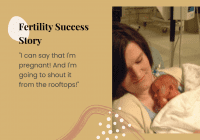With as many as 15% of Canadians turning to fertility treatments, there are several options available when trying to conceive. One of the most prevalent fertility treatments is in vitro fertilization (i.e. IVF), which you have likely heard of before but may not know much about.
If you are trying to grow your family, this guide will help you to understand the basics of in vitro fertilization (IVF) and whether it may be a fit for you.
- What is IVF?
- How does the IVF treatment process work?
- Who is IVF for?
- What are the success rates of IVF?
- How many IVF cycles are recommended?
- How much does IVF cost in Canada?
- What are the side effects of IVF?
All Your IVF Questions Answered
What is IVF?
IVF stands for in vitro fertilization. It’s one of the more widely known types of fertility treatment. Moreover, this assisted reproductive technology uses a combination of surgical procedures and medicines to help sperm fertilize an egg outside of the human body.
Previously referred to as a “test-tube baby,” an embryo will begin to form. Next, once a healthy embryo forms, doctors will carefully place this embryo into the uterus, where hopefully it’ll implant and a fetus will grow to term.
How the IVF Treatment Process Works
To achieve a successful round of IVF, you will need to go through five steps: ovarian stimulation, egg retrieval, sperm retrieval, fertilization, and embryo transfer. Completing this entire process will take 1-2 months.
1. Ovarian Stimulation and Injections
First, at the start of the IVF journey, you will take multiple hormone injections to prepare for egg retrieval.
At the beginning of your menstrual cycle, you will receive daily injections of follicle-stimulating hormone (FSH) and luteinizing hormone (LH) for 8-14 days. These hormones help your body mature multiple eggs during the cycle, giving the doctor several eggs to collect at the retrieval appointment and improving your chances of conceiving.
Then, after these 8-14 days of regular injections, you will take another injectable medication to complete the final step in egg maturation and prepare the eggs for retrieval and fertilization.
2. Egg Retrieval
Approximately thirty-six hours after taking the final dose of medications, the patient will undergo egg retrieval. Some clinics offer awake sedation, while others provide full anesthesia for this procedure.
As well, the doctor will use an ultrasound probe inserted into the vagina to locate the follicles in the ovary. Then, once the ovary is identified, the doctor will insert a hollow needle through the vaginal wall to retrieve the eggs. The procedure takes about 20 to 30 minutes.
If you are having a fresh embryo transfer in the same cycle, the clinic will start progesterone supplements after your egg retrieval to prepare the lining of your uterus for the embryo transfer.
3. Sperm Retrieval
On the day of your egg retrieval, your partner will provide a semen sample through masturbation. Alternatively, you might use a sperm donor. Also, in some cases, a surgical procedure to extract sperm directly from the testis or epididymis may be necessary. Next, after collecting the semen, a sperm-washing process will separate the sperm from the seminal fluid.
4. Fertilization
The doctor will then perform fertilization on the same day as the egg retrieval using one of two methods:
- Conventional fertilization: The doctor places each egg in a dish with numerous sperm, allowing fertilization to occur without manipulation. The fertilized eggs are then incubated.
- Intracytoplasmic sperm injection (ICSI): The doctor injects a single sperm into each egg. This method is typically used if male factor infertility is a concern or if previous IVF attempts have failed.
Once the embryo develops in the lab, it will be ready for transfer into the patient’s uterus, usually five days after retrieval, though it can be done three days later. Any extra embryos can be frozen for future use.
5. Embryo Transfer
Finally, the embryo transfer takes place three or five days after egg retrieval.
To guide the transfer, you will need a full bladder so the doctor can use ultrasound. The doctor will insert a catheter into the cervix as an introducer, then pass a second catheter containing the fertilized embryo(s) suspended in fluid through the introducer into the uterus. Then, the doctor will use a syringe to release the embryo(s) into the uterus before removing the catheters.
The procedure is relatively painless, similar to a pap smear, and takes about five minutes.
If the procedure is successful, you should have an active pregnancy within 6-10 days following egg retrieval. The doctor will order a pregnancy test about twelve to fourteen days after the embryo transfer.
Fertility Success Story

Fertility Success Story: Meet Kristin & Greyson
After a long fertility journey, Kristin’s family grows with her beautiful son Greyson.
Who is IVF For?
IVF offers a fertility treatment option for a wide range of women and couples trying to conceive, including:
- Those who have been unsuccessful with intrauterine insemination (IUI),
- Women with reduced egg quality/quantity
- Men with reduced sperm quantity/quality
- Women with blocked Fallopian tubes
- Those wanting to avoid passing on a specific genetic mutation,
- Those with recurrent pregnancy loss (miscarriage)
- Cancer survivors
- Those using an egg donor or gestational carrier
- Those using previously frozen eggs
IVF can treat common causes of infertility, such as:
- Fallopian tube damage
- Polycystic ovary syndrome (PCOS)
- Premature ovarian failure
- Endometriosis
- Uterine fibroids
- Male factor infertility
IVF is also a suitable option for single individuals or members of the LGBTIQ community planning to start a family using a surrogate.
What are the success rates of IVF?
IVF success rates depend on several factors, including the cause of infertility, the age of the parents, and the clinic performing the procedure. In 2016, the Canadian Fertility and Andrology Society reported 16,852 IVF cycles, resulting in 2,438 pregnancies.
The clinical pregnancy rates per embryo transfer that women can expect are:
- 41% for women under 35 years old.
- 34% for women aged 35-37 years.
- 24% for women aged 38-40
- 11% for women aged 41-42
- 6% for women 40 years old and over.
How many IVF cycles are recommended?
If you’re planning to undergo IVF for the first time or have already experienced an unsuccessful cycle, experts recommend trying at least three IVF cycles. Studies show that women who conceived through IVF typically went through an average of 2.7 cycles. After three IVF cycles, pregnancy rates for women of all ages ranged from 34 to 42 percent.
How much does IVF cost in Ontario?
In Canada, IVF treatments typically cost between $10,000 and $15,000 per cycle. As well, fertility drugs, additional tests, and consultations can sometimes raise the total cost to around $20,000.
The Province of Ontario offers financial assistance through the Ontario Fertility Program, providing funding to help eligible patients build their families. This program covers all forms of infertility, whether medical or non-medical, regardless of gender, sexual orientation, or family status.
As well, the Ontario government provides one funded IVF cycle per lifetime for every woman in the province who holds a valid Ontario Health card and is under 43 years of age. This funding includes cycle monitoring, egg retrieval, ICSI, assisted hatching, and embryo freezing. It also covers the transfer of any frozen embryos in a subsequent cycle, as long as they were created from the original funded IVF cycle.
Coverage in Ontario
[/norebro_text]What's covered
- Your initial fertility consultation
- Most investigative tests
- Most blood tests
- Ultrasound examinations
- Cycle monitoring for diagnosis and treatment
- Intrauterine insemination (IUI)
What's not covered
- Any medications you are required to take during the course of an IUI, IVF, or frozen embryo transfer cycle
- Sperm washing prior to an intrauterine insemination procedure
- The cost of any sperm required to do a donor insemination for IUI or IVF
- The storage of any fertilized eggs (embryos)
- Any adjunctive procedures associated with the IVF cycle, e.g. pre-implantation genetic testing
- The cost of donor eggs
- The cost of using a gestational carrier
What are the side effects of IVF?
Each stage of the IVF process may cause side effects, similar to other medical procedures. The most common side effects occur during the early stages of IVF injections, such as:
- Soreness and/or bruising at the injection site
- Breast soreness
- Nausea
- Fatigue
- Mood swings
- Abdominal pain
- Bloating
- Ovarian hyperstimulation syndrome (OHSS)
As well, the risks of the egg retrieval procedure include:
- Bleeding
- Infection
- Injury to surrounding structures e.g. bladder and rectum
Your fertility specialist can address any questions or concerns about IVF risks and guide you through the side effects.
Learn More about IVF at Dr Tanya Williams Fertility Centre
At Dr. Tanya Williams Fertility Centre, we help you explore fertility treatment options and support your journey to growing your family. Book a consultation with our IVF clinic in Toronto today to learn more.





